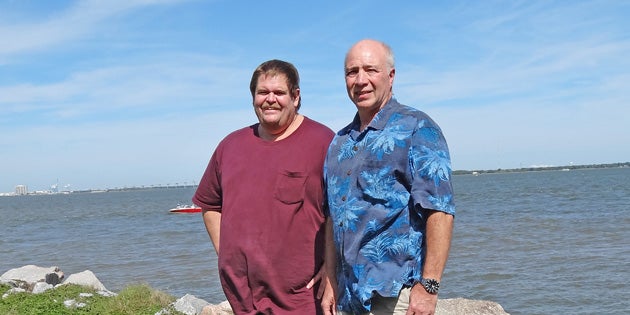When it comes to researching a scientific problem as enormous and complex as climate change, College of Charleston Marine Biology Professor Jack DiTullio and Research Associate Peter Lee believe that two heads are better than one.
For the past several years, DiTullio and Lee have collaborated on several research projects examining how changes in the sea and ice formations impact the earth’s ability to regulate its climate.
In 2013, DiTullio and Lee spent two months in Antarctica as part of a research expedition to study carbon production in the Ross Sea in Antarctica. Recently, they received a grant to continue their work in Antarctica in 2017. They were also awarded a grant to purchase a mass spectrometer device that will enable them to measure compounds related to their Antarctic research as well as other scientific projects.
The College Today caught up with the researchers to learn more about their collaborations and how they are bringing their expertise to bear on the defining environmental issues of our time.
Q: Tell us about your 2013 research in Antarctica and what has come of it thus far.

The 2013 College of Charleston Antarctic Team (clockwise from lower right): former graduate student B. Jacob Kendrick; Swiss international graduate student intern Gianluca Paglia; Dr. Peter Lee; former undergraduate student Rachel Stevens; former graduate student and technician Amanda McLenon; and Dr. Jack DiTullio.
A: In 2013, a field team of six that included a graduate and undergraduate student from the College participated on an oceanographic expedition to the Ross Sea in Antarctica. The project focused on TRacing Algal Carbon Export in the Ross Sea (TRACERS).
We embarked on the US icebreaker RVIB Nathaniel B. Palmer at McMurdo Station on February 10, 2013. After performing experiments investigating the carbon cycle in the western Ross Sea and Terra Nova Bay region, we disembarked in Punta Arenas, Chile, 54 days later. The TRACERS project involved collaboration with scientists from the University of Miami, Old Dominion University, Stanford University and the Institute for Systems Biology in Seattle, Wash.
Our main objective was to quantify production and sinking export of carbon in the water column during the late summer to early autumn season. We believe that this carbon production in the late growing season may be more important than previously recognized in transporting organic carbon to deep water and thereby sequestering CO2 out of the atmosphere, which can help defer or mitigate global warming.
We are currently finishing up our lab analyses and preparing for a project workshop to be held at the Association for the Sciences of Limnology and Oceanography (ASLO) winter meeting in February 2015.
RELATED: Read more about the 2013 expedition to Antarctica.
Q: You were recently awarded $575,000 through the National Science Foundation’s Major Research Instrumentation Program to purchase a field-deployable mass spectrometer instrument as part of your research in Antarctica. How will this instrument be used and where and when do you plan to deploy it?
 A: We were funded to purchase a Proton-Transfer-Reaction Mass Spectrometer. This new instrument is specifically designed to analyze dissolved gases (e.g. oxygen or nitrogen) or highly volatile organic compounds (think pluff mud smell!) in water or atmospheric samples. We will now be able to simultaneously measure a variety of climatically important compounds such as carbon dioxide and methane, which are greenhouse gases, or dimethylsulfide and ammonia, which are involved in cloud formation. Previous techniques have only allowed us to measure one or two of these compounds at a time.
A: We were funded to purchase a Proton-Transfer-Reaction Mass Spectrometer. This new instrument is specifically designed to analyze dissolved gases (e.g. oxygen or nitrogen) or highly volatile organic compounds (think pluff mud smell!) in water or atmospheric samples. We will now be able to simultaneously measure a variety of climatically important compounds such as carbon dioxide and methane, which are greenhouse gases, or dimethylsulfide and ammonia, which are involved in cloud formation. Previous techniques have only allowed us to measure one or two of these compounds at a time.
While the new instrument will become a key tool in our Antarctic research, it can also be used in projects essentially anywhere in the world. In fact, we were also recently funded to study the effect of vitamin B12 on phytoplankton growth and bacterial processes on eight cruises in the South Atlantic Bight off the coasts of South Carolina and Georgia. The first deployment of the new instrument will be a seven-day expedition in March 2015 aboard the RV Savannah from the Skidaway Institute of Oceanography in support of the B12 project.
While the new mass spectrometer will significantly enhance our own oceanographic research activities, it will also strengthen the College’s position as a research partner at Fort Johnson. For example, in collaboration with Dr. Mike Janech at MUSC’s Division of Nephrology, the instrument will be used to look for blood or urinary biomarkers that might indicate kidney stress or even predict kidney failure in mammals, including humans.
Q: You have also received a grant of $384,618 from the National Science Foundation to continue your 2013 research in Antarctica. Tell us about this new project?
A: Our new project is related to our 2013 TRACERS research. Our new NSF grant “Convective Overturn in the western Ross Sea” (CONVEX) was funded as part of a larger project entitled “Polynyas, Ice Production, and Seasonal Evolution in the Ross Sea” (PIPERS).
This project includes a 64-day research expedition to the western Ross Sea in April-June 2017. Our research program will take advantage of detailed physical measurements of sea ice formation, upper water column circulation, atmospheric dynamics and air-ice-sea exchange made by the PIPERS program. We hope to unlock “the black box” of autumn by quantifying the poorly understood links between the physical environment and the dramatic biogeochemical and biological transitions that occur in the Ross Sea during austral fall.
Q: How does your research enhance our understanding of climate change, its causes and effects?
A: One area of our research centers on the role of dimethylsulfide (DMS) in climate cycles. It is produced in the oceans but has a critical role in the formation of clouds, and as a consequence, scientists hypothesize that the biogeochemical cycling of DMS may be an important climate regulation mechanism that could both impact and be impacted by climate change.
However, to understand that role, we must look at the factors that affect the formation and degradation of DMS in the ocean. DMS is derived from a compound called dimethylsulfoniopropionate (DMSP). DMSP is a metabolite produced by phytoplankton to allow them to regulate their intracellular biochemistry against changes or disruptions caused by changes in their environment. DMSP production can be affected by a variety of environmental parameters including physical factors (e.g. temperature and salinity) and chemical factors (such as the availability of nutrients like nitrate and iron).
When certain phytoplankton species are grazed or lysed by viruses, the DMSP is released into the water and converted to DMS by bacteria. The efficiency of that conversion is also affected by a variety of environmental parameters. Our research focusses on quantifying the effects of those environmental parameters.
Q: What is the role of marine environments in climate change?
A: The most significant biogeochemical transformations that occur on the Earth are carried out by microbes. There now exists strong data that man has significantly impacted marine microbial processes and biogeochemical cycles that are intimately involved in regulating the Earth’s climate (e.g. IPCC, 2014 report).
RELATED: Learn more about the Intergovernmental Panel on Climate Change.
Although Earth system science is an interdisciplinary field, the marine biosphere, and polar ecosystems in particular, will have a disproportionate impact on climate. Numerical models indicate that polar and subpolar regions will be significantly impacted this century by climate change processes, such as enhanced ocean warming, stratification and acidification.
Understanding how ongoing changes in the environment will impact marine microbial cycles and species composition in the future will be pivotal to understanding man’s impact on climate.
Q: How do your respective academic backgrounds and research interests come together when collaborating on projects?
A: We collaborate quite extensively on almost all projects. Irrespective of who is leading any given project, there is generally input from the other. It can be as simple as acting as a sounding board for ideas for experiments or logistics for expeditions to playing devil’s advocate when preparing results for publication or writing new proposals. We have similar research interests and both have graduate degrees in Oceanography, but have slightly different backgrounds with respect to our major disciplines and technical expertise within Oceanography. DiTullio is more Biological Oceanography; Lee is more Chemical Oceanography.








